|
F1 A.D. Specials - Simtek |
||||||||
|
• BEGINNINGS
It's probably fair to say that for most dud teams, if only the cards (e.g. driver line-up, engine deal, sponsorship) had fallen the right way, they would have escaped mention on this site. But the story of Simtek was a heart-breaking example of all the cards falling the wrong way. Simtek Research (short for Simulated Technology) was the brainchild of none other than Max Mosley and Nick Wirth, touted in the early 1990s as "the next superstar designer" by March designer Robin Herd. Though Mosley had left after his appointment into officialdom, as a research and development company Simtek had done some work for the FIA, as well as for BMW and Ligier. But perhaps more embarrassingly Wirth had also designed a car for the farcical Andrea Moda team in 1992.
• PAY DRIVER NEEDED But in 1993, with triple World Champion Sir Jack Brabham as a shareholder in Simtek, Wirth decided to take the plunge into Formula One as a team in its own right for 1994. Part of the package saw David Brabham fill one seat, while customer Ford HB engines were obtained. Money, as ever, was a problem, and though Wirth successfully paid the US$500,000 new team entry fee, throughout pre-season testing the car ran without sponsorship. Looking for a pay driver to drive the other car, Simtek entered into earnest negotiations with none other than Andrea de Cesaris, who had healthy Marlboro backing, and also with Brazilian Gil de Ferran, who eventually took his money from meat-packaging company Sadia over to America. Wirth looked next to Jean-Marc Gounon, but the Frenchman had commitments for the first half of the season, and finally the likeable Austrian Roland Ratzenberger was given his F1 break for the first five races. With Ratzenberger aged 31 and Brabham 28, Wirth (27) was the only team boss younger than his drivers.
• TRAGEDY AT IMOLA
While experienced team manager Charlie Moody encouraged the team members to treat the season as an adventure, it seemed as though the best Simtek could hope for was to beat fellow debutants Pacific. But disaster struck early. After Brabham brought the car home 12th in Brazil, and Ratzenberger (pictured left) in his first start did likewise in 11th spot at Aida, during qualifying at Imola the Austrian plunged straight-on at the flat-out 'Villeneuve' corner (right) and died of a broken neck. He was the first fatality in F1 since Elio de Angelis died in testing in 1986. Telemetry showed that the previous lap he had had an off, and probably damaged the front wing. The front assembly then loosened, the car lost downforce and ploughed into the wall. To say that the team was left devastated and confused would be an understatement. And though traditionally the other team driver would withdraw in such a situation, seeing the demoralisation around him, Brabham bravely decided to race on. Many see this as the pivotal moment which kept Simtek going. In Ratzenberger's memory the team then made a collective decision to see out the season.
• THE YEAR FROM HELL
But there was still more to come; for Spain the team signed talented Italian Andrea Montermini (pictured on right) who then had another sickening accident coming onto the front straight on his quick lap. It left another chassis destroyed, and another driver hurt, though this time Montermini escaped with relatively minor injuries. That Simtek pushed on through all this was a tremendous tribute to their fighting spirit. Montermini had been signed for both Spain and Canada before Gounon would be available to drive in the eight races after that. But after the Italian fractured a bone in the heel of his left foot, once again Simtek was forced to take only one car to Canada while yet another new chassis was being built up.
• EGG ON COMAS' FACE
Brabham, though, in the words of the Autosport season review, was one of the heroes of the season. Despite his car's obvious disadvantage, he managed to challenge the Lotuses and Larrousses and occasions beat them. His average grid position was better than 23rd, and he put egg on Erik Comas' face in Belgium by outqualifying the Larrousse, only a race after the Frenchman had promised jokingly to retire should he ever be lower on the grid than a Simtek. But all jokes aside, Brabham's best was 10th in Spain despite regular reliability problems, and his efforts throughout the season held the team together, though two tangles with Jean Alesi in Monaco and Portugal didn't put him on the Ferrari driver's Christmas card list.
• GOOD BYE TO BRABHAM FOR 1995 But towards the end of 1994 money was again beginning to be tight, and after Gounon left the team Wirth was once again on the look-out for a pay driver, and signed Domenico Schiattarella for Jerez and Adelaide. Though the Italian didn't bring all that much cash, it was a bargain basement deal that brought a steady driver into the team. As it turned out, Mimmo came 19th at Jerez and impressed with his approach.
There were more disappointments still at the end of the torturous 1994. Though Brabham had supposedly been committed long-term to Simtek, he received an offer to drive for BMW in the British Touring Car Championship, and this was too good to refuse. Add to that a decrease in MTV's commitment for 1995, and financially the team was spiralling downwards. But Wirth decided to push on into 1995 with the new S951, whilst keeping Schiattarella and loaning the quick Dutchman Jos Verstappen from Benetton.
• S951 A REVELATION
Jos was as good as his word in Argentina, undoubtedly Simtek's best ever race. There he qualified a fabulous 14th, and making a lightning start moved all the way up to the points by the first round of pit stops. To prove his competitiveness it seemed as though there was no way Gerhard Berger's Ferrari could get around him. But it all came undone at the pit stop, where Simtek's equipment was substandard, and soon afterwards Verstappen's gearbox gave up. Nonetheless, Schiattarella picked up the pieces and came home 9th.
• MONEY TROUBLE WINS OUT But money was becoming a desperate struggle. At Monaco for round five, Wirth made a public appeal for backers, revealing that in 18 months the team had amassed a 6 million pound debt, especially after "a broken deal" and "bogus bank transfer documents". Though some potential backers were interested, none were prepared to take the plunge. As a result of the shortage of funds, Simtek could only bring three troublesome gearboxes to Monaco, and then Verstappen proceeded to slap the wall twice. In perhaps a symbol of their imminent doom, both cars retired with gearbox trouble on the opening lap. The backers never came and Wirth was forced to close down the team after the Monaco disaster, leaving 48 crew out of a job. Who knows how many good reputations could have been made if Simtek got the money it needed and saw through 1995 with a more reliable car? My guess is that Verstappen would have picked up anything up to half a dozen points.
|
||||||||
| back |


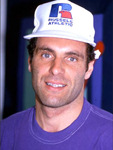 Though a major backer in MTV was signed in time for the start of the
season, it was clear a tough year was in store. The Ford HB engine obviously had a power
disadvantage. And while Wirth had planned for his original design to feature active
suspension, new rules of 1994 banning driver aids meant that his eventual S941 design was conservative and
overweight. For example, initially the car ran with a fully manual gearbox.
Though a major backer in MTV was signed in time for the start of the
season, it was clear a tough year was in store. The Ford HB engine obviously had a power
disadvantage. And while Wirth had planned for his original design to feature active
suspension, new rules of 1994 banning driver aids meant that his eventual S941 design was conservative and
overweight. For example, initially the car ran with a fully manual gearbox.
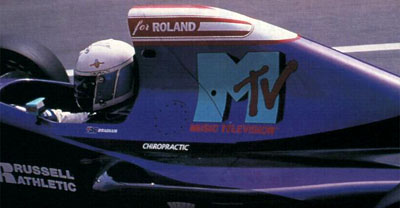
 Simtek ran only one car at
Monaco, where Karl Wendlinger had an accident in his Sauber which left him in a deep
coma. Many Simtek mechanics had worked for Wendlinger at March, and this was yet another
blow.
Simtek ran only one car at
Monaco, where Karl Wendlinger had an accident in his Sauber which left him in a deep
coma. Many Simtek mechanics had worked for Wendlinger at March, and this was yet another
blow.

 But with
But with 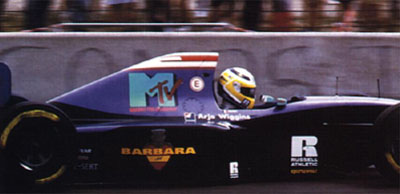
 Not so
Not so 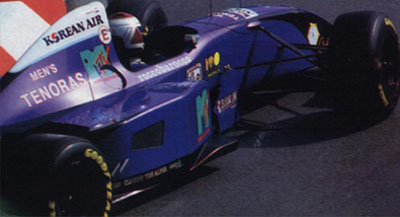
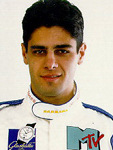 Right from the
outset, it was apparent that the S951 was one giant leap for Simtek. Using ex-Benetton gearboxes and a Ford ED
engine, it was a car that could definitely beat the Pacifics and Fortis; and the performances of
Right from the
outset, it was apparent that the S951 was one giant leap for Simtek. Using ex-Benetton gearboxes and a Ford ED
engine, it was a car that could definitely beat the Pacifics and Fortis; and the performances of 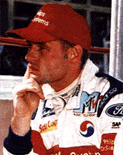 But in the hands of Verstappen (pictured on right), at times the car was
flying, managing to mix it with the Minardis, Tyrrells and Arrows. He reported that it was an easy car to
drive, rather like a go-kart, and as a result it encouraged him to go fast and stay on the
track. That coming from a driver whose debut season in 1994 for Benetton was littered by mistakes and off-track
excursions.
But in the hands of Verstappen (pictured on right), at times the car was
flying, managing to mix it with the Minardis, Tyrrells and Arrows. He reported that it was an easy car to
drive, rather like a go-kart, and as a result it encouraged him to go fast and stay on the
track. That coming from a driver whose debut season in 1994 for Benetton was littered by mistakes and off-track
excursions.

